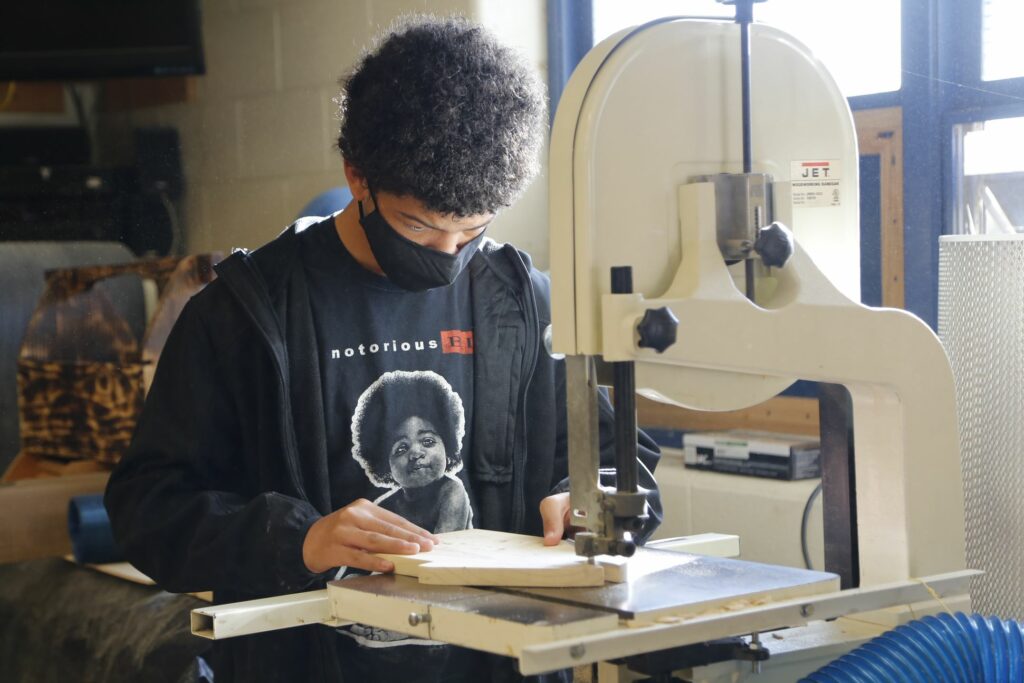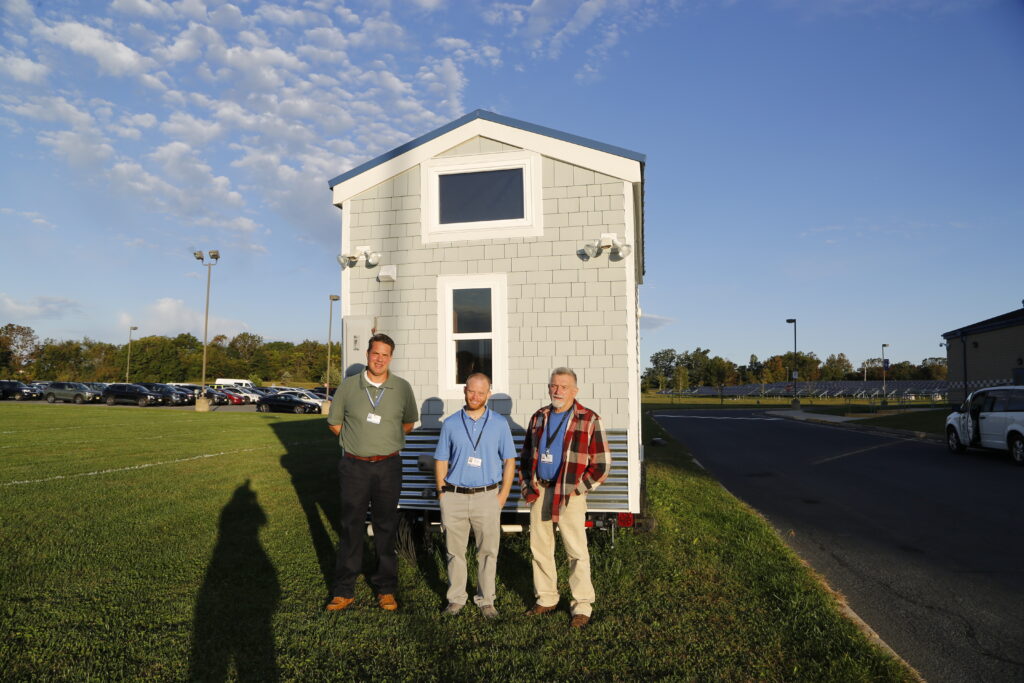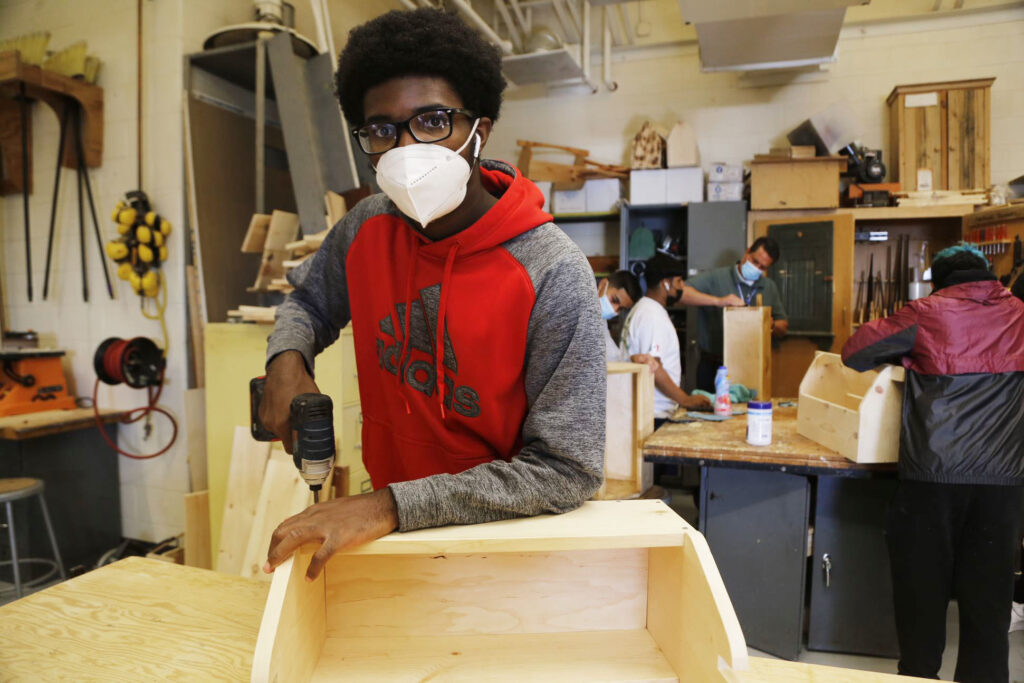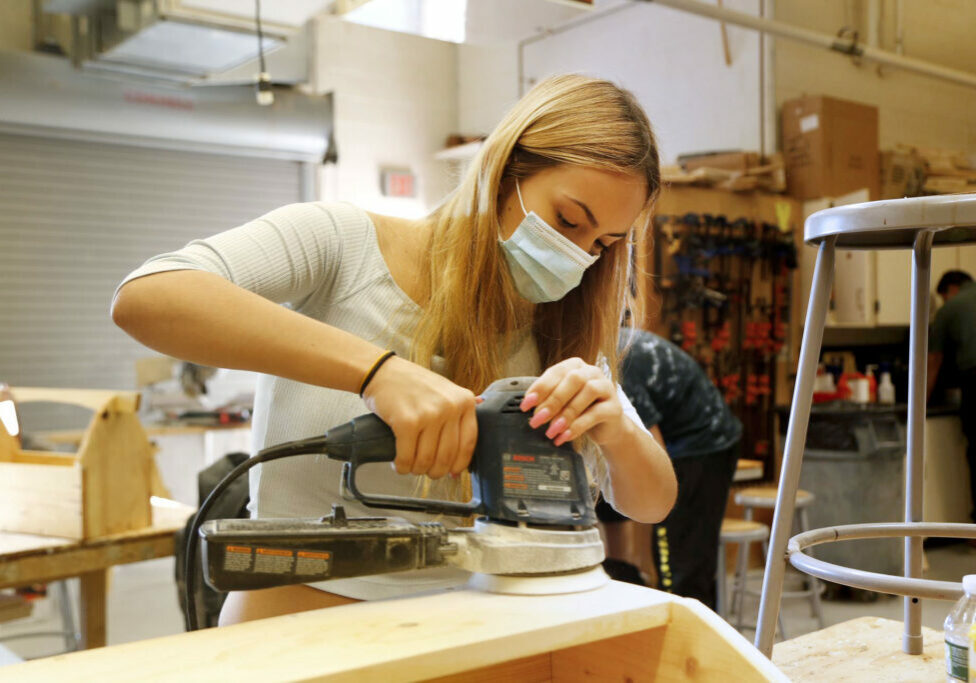By Kathryn Coulibaly
As you enter Hammonton High School, Rick Cote’s woodworking classroom is directly across from the main office. Kept painstakingly neat by students who sweep and sanitize after every class, Cote’s classroom is full of a variety of tools, materials and supplies, including traditional stationary woodworking tools alongside the latest portable lithium-ion rechargeable tools and drivers, as well as hand tools from the early 1960s and ‘70s.
Today, students are working on building their own toolboxes, at their own pace, with their own modifications.
“The students who take this class have a variety of skill levels, language abilities, and comfort with building things with their hands,” Cote said. “This class helps them build skills and gives them a break during the day when they can concentrate on building something, which can boost their self-esteem.”
Cote showed the students the basics of constructing their toolboxes, and then, under his careful supervision, left the rest up to them. Some students chose to varnish the wood; others left it with just a protective glaze. Some used a torch to burn their toolboxes’ exteriors, giving them a weathered look. Others built intricate trays to divide up materials. Despite using the same materials and the same general plan, each toolbox is as unique as the students constructing them.
Woodshop is one of many hands-on classes at Hammonton High School. The Career and Technical Arts program encompasses a variety of subject areas, including graphic design, TV/media, culinary arts, architecture, jazz band and chorus, and woodworking.
These types of classes engage and challenge students in different ways from other subject areas, but they can all work together. Cote collaborates with his colleagues in woodworking, Matthew Arena and Gene Luby, as well as teachers across the curriculum.

Learning real-world skills
Due to budget cuts and an over-emphasis on standardized testing, woodshop classes are increasingly disappearing from New Jersey’s public schools, despite the fact that they teach students real-world skills that can be applied in their lives regardless of the career paths they choose.
At Hammonton High School, the woodworking classes are electives and are popular with a wide range of students. Some of the students have parents who work in the trades—electrical, plumbing, HVAC, carpentry, and more.
One student, Angelina, said she was interested in taking the class because she watched her house being built and wanted to learn how to make things.
Many of the students are children of migrant workers. Language skills can vary in the class, but the students help each other and cheer each other on.
“One student had very limited English, but he turned out to be an amazing carver,” Cote said. “The other students make requests. He’s carved lots of different animals, from ducks and eagles to bugs, sharks, and penguins.”
Some students develop their own independent study programs. They come up with a project, draw out the specifications, and work with Cote to learn how to use the tools they will need to complete the project.
“We show the students how to use the different tools and then we’re always there to assist them if they get backed into a corner,” Cote said.
The tiny house project
Hammonton’s woodworking teachers, Cote, Arena and Luby, also teach other classes on design, career readiness, and more. All three of them recently completed a multiyear construction project building a tiny house.
They worked with other teachers to complete the vision of now-retired Hammonton woodworking teacher James Ziegler, who started the tiny house construction project in 2017. Ziegler wanted to inspire the students with an ambitious project that would showcase many of the life skills he and his colleagues were working to instill in them.
Over the four years it took to complete the project, more than 500 students and staff members worked on the tiny house. The finished product is a beauty: wood framing, gray laminate flooring, walnut interior walls, a kitchen, bathroom with washer/dryer hook-up, loft bedroom, living room area with sliding glass entry door, fiberglass insulation, and heating and air conditioning.
Hammonton’s tiny house was put up for auction in September 2021 and the district is hoping for bids of $30,000 or more. The funds will be used to repay a contribution by the Hammonton Education Foundation and to initiate other innovative projects showcasing these hands-on skills.

From left: Woodshop teachers Rick Cote, Matthew Arena and Gene Luby stand beside the tiny house Hammonton High School woodworking students and staff built.
A skilled-trades shortage
The opportunity to learn hands-on skills is dwindling in New Jersey’s public schools, and across the country. Nationally, between 1990 and 2009, the number of credits earned in CTE high school classes dropped by 14%, according to the Brookings Institution’s 2017 report, “What we know about Career and Technical Education in high school.”
Even before the pandemic, the United States was forecasting a shortage of skilled trades. Since the pandemic, the demand is soaring. Here are just a few of the most in-demand trades:
- Concrete masons report a 904% job growth.
- Window glaziers are at 422%.
- House painters are at 329%.
- Electricians are at 130%.
- Plumbers are at 129%.
- Carpenters are at 121%.
In 2015, well before the pandemic, Time magazine reported on a widening gap between the jobs that were needed and the skills being taught in schools.

Career and Technical Education gives students skills that they can use personally and professionally.
Cote sees the opportunities for his students and wants to help them act upon it.
“There are so many industries in this area crying out for skilled workers,” Cote said. “They’re even willing to train you, so long as you have a willingness to learn. These are good, in many cases unionized, jobs. I want to help my students see the potential in these careers.”
Cote takes his role as a teacher very seriously. He takes an interest in his students inside and outside the classroom. In nearly every class, he talks to students about their career options after high school. With his connections in the community, Cote is able to help students find work in a variety of fields after graduation, from landscaping to electrical to HVAC to construction.
“Woodworking gives students a sense of accomplishment that really helps build them up,” Cote said. “They see a project through from beginning to end. They make mistakes and they learn how to ask for help to fix those mistakes—and there’s always a solution. Sometimes, you just need a little wood glue. They help each other, too, and a student who may not shine in biology is knocking it out of the park in woodshop. Every student deserves to have a chance to shine, and that’s what career and technical education can provide.”
Kathryn Coulibaly is the associate editor of the NJEA Review and provides content and support to njea.org. She can be reached at kcoulibaly@njea.org.
